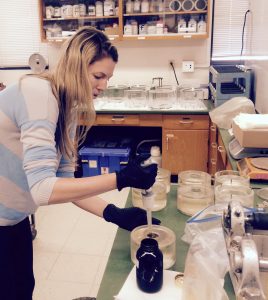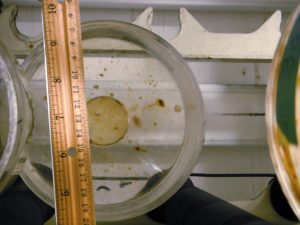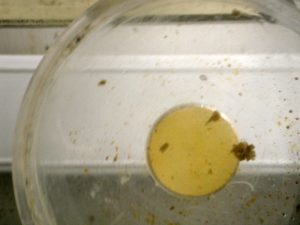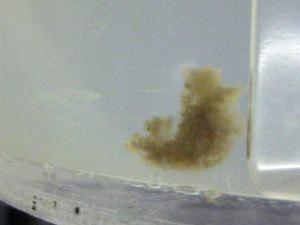Study Explains Pathways for Oiled Marine Snow Formation
– March 24, 2015
University of California Marine Science Institute researcher Uta Passow investigated the formation of aggregated oil and organic material, commonly called marine snow, after the Deepwater Horizon spill.
She found that microbes and plankton had distinct interactions with oil, subsequently providing alternate marine snow development pathways, and that the presence of Corexit likely inhibited the formation of microbial-generated marine snow. Passow published her findings in the October 2014 issue of Deep Sea Research II – Topical Studies in Oceanography: Formation of rapidly-sinking, oil-associated marine snow.
The formation of marine snow, which are sinking composite particles greater than 0.5 millimeters, is a common ocean process that rapidly transports particles from surface waters to the sea floor. The continental shelf topography of the northern Gulf of Mexico facilitates a suspended sediment zone. Additionally, the northern Gulf receives inorganic particle inputs from rivers, run-off, and coastal erosion. These subsurface conditions along with natural hydrocarbon seafloor seeps provide an environment favorable for the formation and sinking of oiled mineral aggregates.
Macondo oil accumulated at the sea surface and in subsurface plumes. Prior research has documented observations of large (millimeter to centimeter sized) sinking marine snow near surface slicks from the spill (Passow, et al., 2012) and flocculent oily material that coated coral reefs near the spill site (Fisher, et al., 2014). In this study, Passow used roller table experiments to investigate the conditions that induce marine snow and the effects of oil type (Louisiana light crude, Macondo oil, and bucket-collected spill oil), photochemical weathering, and phytoplankton and dispersant presence on its development.
Seawater treatments, with no particles greater than one millimeter present, incubated with collected spill oil formed centimeter-sized marine snow rich with microbial-generated mucus. Smaller, yet similar, marine snow formed in incubations with weathered crude oil. Marine snow formed even when spill oil was added to artificial seawater, suggesting that the oil included the microbial community responsible for snow formation.
Phytoplankton presence in seawater treatments resulted in appreciable carbon amounts (16%-65%) incorporated in diatom aggregates, independent of oil type. However, the oil type did affect aggregates’ appearance, size, and dynamics and likely increased the stability, cohesion, and sinking speed of these plankton aggregates.
Low concentrations of Corexit 9500A in treatments slowed, reduced, or completely inhibited microbial-mediated snow production. Conversely, higher dispersant concentrations produced buoyant oil aggregates that did not sink, suggesting that the oil contributed to the cohesion and stability of Corexit-mediated aggregates.
Passow explained that “this study contributed a central piece towards the understanding of the mechanisms that lead to oil-sinking products.” In her discussions, she said that microbial-mediated marine snow may provide a potentially effective mechanism for surface oil removal. While acknowledging the difficulty in currently assessing Corexit’s overall effects on oily marine snow, she suggested that Corexit likely reduced post-spill snow perhaps by impacting bacterial exudates or promoting a shift in less mucus-generating strains.
These experiments demonstrated the potential of microbial-mediated or plankton-aggregate snow to transport oil carbon to the seafloor. Passow recommends that future modeling efforts and oil spill budget calculations should include marine snow as an oil distribution mechanism and include inputs on microbial and phytoplankton populations and oil weathering rates. Additionally, scientists should re-evaluate dispersants as a mediating measure.
Oil-associated marine snow formation and its subsequent transport is the focus of a larger dedicated effort. Passow explained, “MOSSFA (Marine Oil Snow Sedimentation and Flocculent Accumulation) is a working group that facilitates investigations of processes leading to the observed seafloor oil accumulation. Founded in May, 2013, the MOSSFA working group organized a workshop, town hall meeting, and continues to hold smaller topic-specific meetings. Recently-funded consortia and the MOSSFA group are working together towards a new marine snow research phase.”
************
This research was made possible in part by a grant from the Gulf of Mexico Research Initiative (GoMRI) to the Ecosystem Impacts of Oil and Gas Inputs to the Gulf (ECOGIG) consortium. Other funding sources included a National Science Foundation RAPID Grant (OCE-1045330).
The GoMRI is a 10-year independent research program established to study the effect, and the potential associated impact, of hydrocarbon releases on the environment and public health, as well as to develop improved spill mitigation, oil detection, characterization and remediation technologies. An independent and academic 20-member Research Board makes the funding and research direction decisions to ensure the intellectual quality, effectiveness and academic independence of the GoMRI research. All research data, findings and publications will be made publicly available. The program was established through a $500 million financial commitment from BP. For more information, visit https://gulfresearchinitiative.org/.
© Copyright 2010- 2017 Gulf of Mexico Research Initiative (GoMRI) – All Rights Reserved. Redistribution is encouraged with acknowledgement to the Gulf of Mexico Research Initiative (GoMRI). Please credit images and/or videos as done in each article. Questions? Contact web-content editor Nilde “Maggie” Dannreuther, Northern Gulf Institute, Mississippi State University (maggied@ngi.msstate.edu).









